 Research Article
Research Article
Nitrogen Fertilizer Rate and Time of Application Affected Yield and Quality of Turmeric (Curcuma longa L) at Tepi, Southwestern Ethiopia
Behailu Mekonnen1* and Weyessa Garedew2
1Tepi National Spices Research Center, Tepi, Ethiopia
2Department of Agriculture and Veterinary Medicine, Jimma, Ethiopia
Behailu Mekonnen, Tepi National Spices Research Center, Tepi, Ethiopia.
Received Date: May 25, 2019; Published Date: June 07, 2019
Abstract
Turmeric is one of the most widely grown spice crop in southwestern part of Ethiopia. However, the yield and quality of this crop is low due to many factors. In 2016/2017 main cropping season, an experiment was conducted to determine the effects of nitrogen rate and time of application on yield and quality of turmeric at Tepi. The study consists of five nitrogen rates (0, 46, 69, 92, 115 kg ha-1) and five split applications time (full dose at emergence, half at emergence + half at lag growth stage, 1/3rd at emergence + 1/3rd at lag growth stage + 1/3rd at tillering stage, 1/4th at emergence + 1/4th at lag growth stage + 1/4th at tillering stage + 1/4th at slow growth stage, and 1/5th at emergence + 1/5th at lag growth stage + 1/5th at tillering stage + 1/5th at slow growth stage + 1/5th at maturity stage ). A split plot design with three replications was used by assigning nitrogen rate as main plot factor while time of application as sub-plot factor. The result revealed that mother and finger rhizome number, mother and finger rhizome weight, fresh rhizome yield and oleoresin content were significantly affected by the interaction effects of nitrogen rate and time of application. The highest value for the variables measured was recorded at three equal split application of 115 kg N ha-1 (1/3rd at emergence + 1/3rd at lag growth stage + 1/3rd at tillering stage). Three times split application of nitrogen produced more yield and better quality as compared to the two times of application in turmeric; the most commonly known time of nitrogen application in many crops. Therefore, turmeric producer in southwestern Ethiopia should apply 115 kg N ha-1 nitrogen in three times split application to maximize their turmeric yield and quality.
Keywords: Oleoresin content; Rhizome yield; Split application; Nitrogen rate
Introduction
Turmeric (Curcuma longa L.) is one of the most widely grown spice crop in southwestern part of Ethiopia. It is a versatile remunerative cash crop and their primary product is the cured dried rhizome. Principally, turmeric has a wide range of values such as orange coloring powder in textile industry, food industry and medicinal values, for its appreciated aroma and flavor and for its oleoresin [1]. According to [2], turmeric is well known in every Ethiopian dish (kitchen) as source of ingredient in the preparation of local sauces “Wot”. Turmeric has become one of the most important cash crops in Ethiopia. Its commercial cultivation in the country is picking up and is likely to become a cash crop with good economic return especially for resource poor farmers. It has also been commercialized in large private farm and huge investment projects at national level, which indicates the bright future of the crop in Ethiopia. The crop offers a good scope for diversification of the existing Arabica coffee (cash crop) based cropping system of southwestern Ethiopia. Ethiopia export turmeric mainly in their dried forms and, little as oleoresin or essential oils extract [3]. In 2013, turmeric accounts 8% (USD 2.1 million) of the total spices export in Ethiopia [4].
The production and productivity of turmeric crop, however, is still low as compared to other major turmeric producing countries. According to [5], the national productivity of turmeric in Ethiopia was 2.4 tones ha-1 in the contrary to 4.0 tones ha-1 in India. This production gap could be due to several factors among which declining soil fertility is one. Several studies reported that turmeric is a nutrient exhaustive crop, particularly nitrogen [6,7]. The high nutrient requirement of turmeric is due to their shallow rooting, prolonged growing period (up to nine months) and the potential to produce large amount of dry matter per unit area [6]. Nutrients uptake in turmeric is also depends on stage of development (a phase of moderate vegetative growth, a phase of active vegetative growth, a period of slow vegetative growth and a phase approaching senescence) [8]. The active vegetative growth and high dry matter production phases are the period during which maximum uptake of nutrients takes place [9].
Since nitrogen is highly mobile, its use and demand are continuously increasing as it is subjected to high loss from the soil plant system [10]. Even under best management practices, approximately 30-50% of applied nitrogen is lost through different mechanisms and, hence, the farmer is compelled to apply more than what the crop needs to compensate for losses through leaching, volatilization, and denitrification [11]. Split application of nitrogen is one of the strategies of improving nitrogen use by the crops [12]. According to [13], time of N application play a significant role in minimizing NO3 – losses from agricultural land, especially for crops grown under wet and warm conditions. It has been also reported that split application of nitrogen keeps the nutrient availability throughout the active growth stages of turmeric [14].
The major turmeric growing areas, southwestern Ethiopia, is well known for its high rainfall area where nutrient loss through leaching is very common. This makes the nutrient unavailable during the critical stages of crop growth. However, in Ethiopia nitrogen has been applied using local practice, half at planting and half at emergence [7]. Therefore, this research was initiated to determine the optimum dose and right time of application that allow maximum yield of turmeric both in quantity and quality so as to meet the national production and export target. Therefore, the objective of this study was to determine the optimum rate of N fertilizer and time of application on yield and quality of turmeric at Tepi, Southwestern Ethiopia.
Materials and Method
Description of the study site
The experiment was conducted at Tepi National Spices Research Center (TNSRC) during the main cropping season (under rain-fed condition), from April 2016 to January 2017. The center is found in Southern Nations Nationalities Peoples Regional State (SNNPR), Sheka administrative zone, at Tepi town, which is located about 611 Km far from Addis Ababa, the capital city of Ethiopia (Figure 1). It is located at 7° 10’ N latitude and 35° 25’ E longitudes. It is situated at the altitude of 1200 meters above sea level representing a lowland altitude and characterized by hot humid with average annual rainfall of 1559 mm and mean maximum and minimum temperature of 30.23 °C and 16.09 °C, respectively [15]. The soil type of the experimental site is classified as Nitisols, which is dominated by a loam texture with a pH range of 5.60 to 6.00 [16].
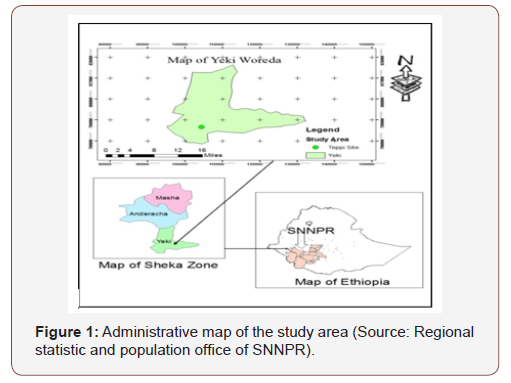
Experimental treatments and design
The treatments consisted of five levels of nitrogen (0,46,69,92 and 115Kg ha-1) and five equal split applications of nitrogen. The time of nitrogen application were adjusted according to [8] growth stage for turmeric plant. Accordingly, the timings of N application were adjusted as follows: first time of application (full dose at emergence); second time of application (half at emergence, half at lag growth stage); third time of application (1/3rd at emergence, 1/3rd at lag growth stage and 1/3rd at tillering stage); fourth time of application (1/4th at emergence, 1/4th at lag growth stage, 1/4th at tillering stage and 1/4th at slow growth stage) and fifth time of application (1/5th at emergence, 1/5th at lag growth stage, 1/5th at tillering stage, 1/5th at slow growth stage and 1/5th at crop approaching maturity stage). At crop emergence, urea was drilled between rows and incorporated into the soil immediately based on the treatments. The second, third, fourth and fifth equal split N urea applications were done by side dressing at the specified growth stages of the crop: at the beginning of July, August and September, and at the end of October 2016, respectively.

The two factors were laid out in a split plot design with three replications. The rates of N were assigned to the main plots while time of N applications was assigned to the sub-plots. The main plot and sub plot size were 21.6 m2 and 3.24 m2 respectively. A distance of 1m and 0.5m were maintained between the main plots and the sub plot, respectively, and a distance of 2m was maintained between blocks. Each plot has six rows of which the four middle rows were used for data collection (Figure 2). The recommended rate of 23Kg P2O5 ha-1 Triple Super Phosphate (TSP) was uniformly applied to all plots at planting. Turmeric variety ‘Dame’, which was released by Tepi National Spices Research Center in 2007, was used for the experiment. It is a high yielding turmeric variety adapted to a wide range of altitudes from low to mid-altitude (up to 2000 m.a.s.l) areas.
Experimental procedures
The experimental field was prepared following the conventional tillage practices before planting turmeric. In accordance with the specifications of the design, a field layout was prepared, and each treatment was assigned randomly to experimental plots within a block. After the seedbeds were leveled, the seed rhizomes ranging from 20-30g [17] of uniform primary finger rhizomes were planted at the recommended spacing of 30cm x 15cm between rows and plants, respectively. Planting was done on 29th April 2016 using manual row maker or hand hoe. Weeds were removed by hand according to the locally recommended practices, starting from crop emergence until the plant canopy becomes closed. Other field management practices were applied as recommended for the crop.
Data collection methods
Yield and yield component data were collected at physiological maturity: when the plant leaves start drying and withering, and quality analysis after harvesting. Accordingly, the following yield and quality related traits were recorded as follows.
Number of mother and finger rhizomes (plant-1): both mother and fingers (primary and secondary) rhizome number were counted during harvesting from eighteen representative sample plants (out of forty plants), after separating the primary and secondary finger rhizomes from their mother rhizome.
Weight of mother and finger rhizomes (g plant-1): was determined similarly during harvesting from eighteen representative sample plants (out of forty plants) and rhizomes were cleaned following harvesting and weighed mother and finger rhizomes separately using an electronic balance.
Fresh rhizome yield: It was calculated from total (mother, primary and secondary) rhizome weight (gram per net plot area) and converted in hectare bases, and the data were expressed as Kg ha-1.
Oleoresin content (W/W) (%): rhizomes were washed, boiled at 100 °C for 45 minutes and exposed to sun drying for six days and then ground into a fine powder. Oleoresin content was measured for each treatment using solvent extraction method based on American Spice Trade Association procedure [18]. To determine the oleoresin content, 100g of powdered samples were taken and put in the thimble. The thimble was covered with a piece of cotton to prevent escape of the sample and then kept in extractors, which linked with solvent flask at the bottom through two tubes. One of the tubes was a side tube for the passage of solvent vapors and the other was a siphon tube for siphoning of the extracted back to the flask of the Soxhlet apparatus. More than half of the flask was filled with petroleum ether of 60 - 80 °C. The assembly was fitted with condenser and then heating started on a heating mantle and the solvent dropped at the center of the thimble. The extraction was continued for 4 hours, after that cooled the samples. Then, the solvent was transferred into the evaporating flask of the rotary evaporator. Rotary evaporator was used for distilling off the solvent generally under vacuum. Finally, the flask was cooled in desiccators, and then weighted and calculated based on the formula described by many authors [18-21].

Statistical Analysis
The data recorded in this study were subjected to statistical analysis. Analyses of variance (ANOVA) were carried out using SAS version 9.2 computer statistical software [22] after checking the assumption of ANOVA. Significant differences between treatments were delineated by Least Significant Differences (LSD) at 5% probability level
Results and Discussion
Mother and finger rhizome number
The result revealed that both the main effects of N rate and time of application, as well as their interaction had significant (P<0.05) effect on the number of mothers, primary and secondary finger rhizomes per plant. The maximum number of mothers, primary and secondary rhizome per plant was obtained when 115Kg N ha-1 was applied in two and three equal splits (Table 1 & Table 2). On the other hand, the minimum number of mother and finger rhizomes per plant was recorded from the unfertilized plant regardless of application time (Table 1 & Table 2). The increase in number of mother and fingers rhizome per plant due to high N application could be ascribed to its roles in growth and tissue differentiation [23]. It can be also explained on the basis of the physiological fact that N plays a major role in protein and nucleic acids synthesis and protoplasm formation. The declined number of mother and finger rhizomes on unfertilized plot, could be due to decreases in leaf number and leaf area per plant with reduced nitrogen level. With such reduced growth parameters, the net photosynthesis might be lower so that it is difficult for the plant to supply adequate amount of substrate to the sinks/rhizomes.
Table 1: Interaction effects of N rate and time of application on number of mother rhizomes (plant-1) at Tepi, Southwest Ethiopia in 2016/17.

Table 2: Interaction effects of N rate and time of application on primary and secondary finger rhizome number (plant-1) at Tepi, Southwest Ethiopia in 2016/17.
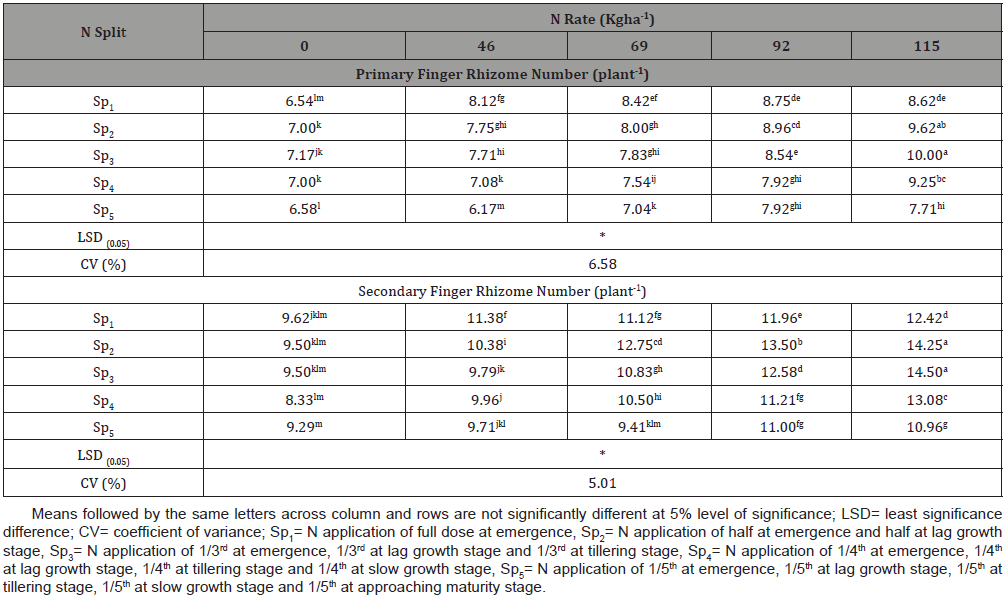
Fresh weight of mother and finger rhizome
The fresh weight of mother and finger rhizomes per plant were significantly (P<0.05) influenced by the main effects and their interaction. The highest fresh weight of mother and finger rhizome per plot was recorded from three equal split application of 115Kg N ha-1 (1/3rd at emergence + 1/3rd at lag growth stage + 1/3rd at tillering stage) while the lowest fresh weight were recorded from the unfertilized plot (Table 3). The increase in fresh weight of mother and finger rhizomes per plant at high rate of nitrogen might be due to the high number of mothers, primary and secondary finger rhizomes per plant recorded at the same rate. An increase of nitrogen level could promote a greater number of leaves per plant which could synthesis more dry matter which acts as substrate for the growth and development of rhizomes.
Table 3: Data Organization for Hierarchically Clustered /Multilevel Data.
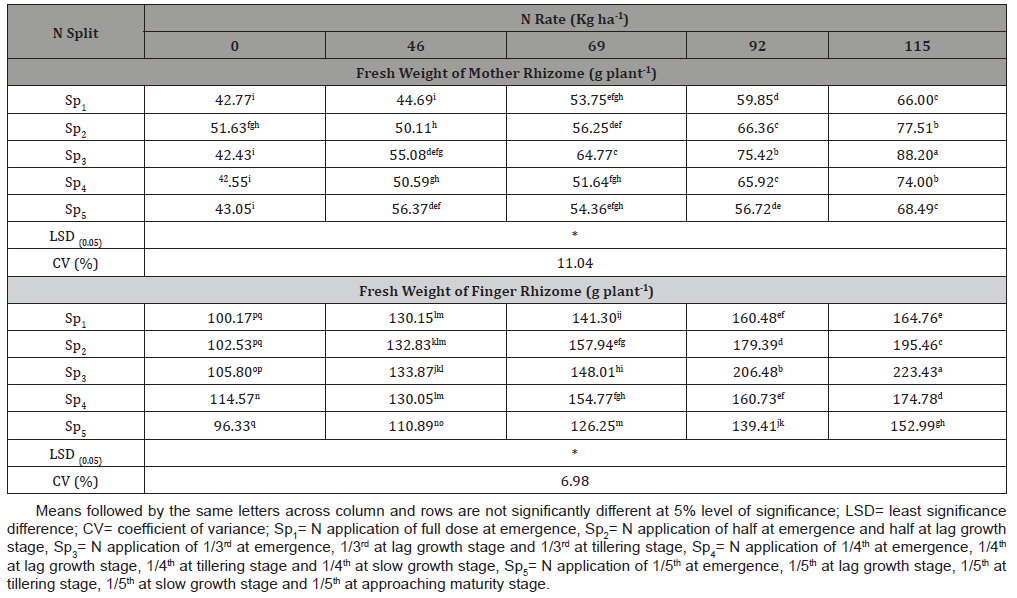
Fresh rhizome yield
Analysis of variance indicated that fresh rhizome yield responded significantly (P<0.05) to the main effects of nitrogen rate, time application and their interaction. The maximum fresh rhizome yield was obtained from plot which received 115Kg N ha-1 in three equal splits (1/3rd at emergence + 1/3rd at lag growth stage + 1/3rd at tillering stage) while the minimum yield was recorded from plot treated with 0Kg N ha-1 (Table 4). The higher average rhizome yield from high rate of nitrogen application could be associated with more luxuriant growth, foliage and leaf area and higher supply of substrate which helped in producing bigger rhizomes, hence resulting in higher yields [24]. Additionally, the higher yields at higher nitrogen level may be due to better stem size and higher number of rhizomes per plant which might result from increase in number of leaf’s per plant with increase in nitrogen level.
Table 4:Interaction effects of N rates and time of application on fresh rhizome yield (Kg ha-1) at Tepi, Southwest Ethiopia in 2016/17.
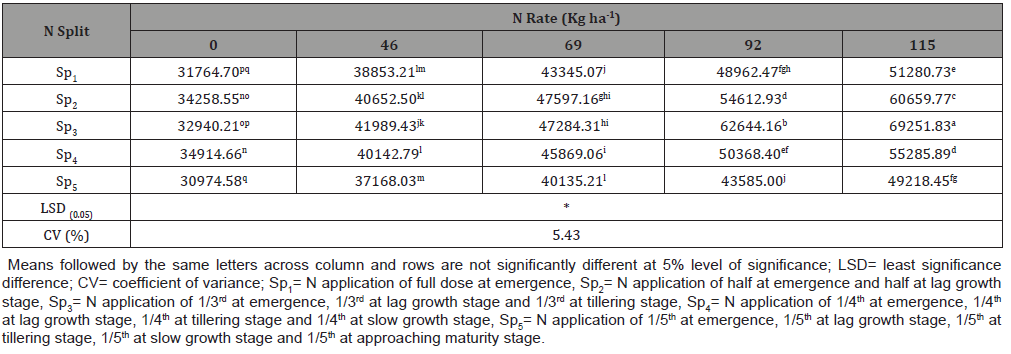
The maximum fresh rhizome yield was recorded from maximum rate of N applied (115Kg N ha-1), indicating that application of N beyond this level might contribute to the yield of the crop. Considering the response of turmeric in rhizome yield in this study, it appears the N fertilizer threshold for high turmeric rhizome yield is high. Therefore, it is further advisable to add more rates of N in future research in order to produce conclusive result with the maximum N requirement of turmeric for maximum yield production. The result also showed that split application of N produces more yield than one-time (full dose) application at planting. In this study even the most commonly used method of application, two-time application, produced less rhizome yield than three-time application indicating that nitrogen loss is high when applied only once at planting or at two-time application.
Oleoresin content
Oleoresin content was significantly (P<0.05) affected by the main effect of nitrogen rate and time of application as well as their interaction. The oleoresin content of the tested treatments varied from 13.18% to 15.52% from unfertilized plot and highest rate of N (115Kg N ha-1) application, respectively (Table 5). The highest oleoresin content exceeded the lowest by 17.75% (Table 5). The increased oleoresin contents in rhizomes along with high level of N application may be due to better nourishment of plant in right growth stage with appropriate quantity. This indicates the positive relations between soil N availability and its uptake, and their functional role in the synthesis of volatile oil and oleoresin in turmeric rhizome. [25] reported that the synthesis and oil contents of aromatic plants were enhanced due to high available of soil N and its uptake by the plants. According to [26], higher doses of N application resulted better accumulation of assimilates leading to improved quality attributes.
Table 5: The oleoresin content (%W/W) of the rhizome as influenced by the interaction of N rates and time of application at Tepi, Southwest Ethiopia in 2016/17.
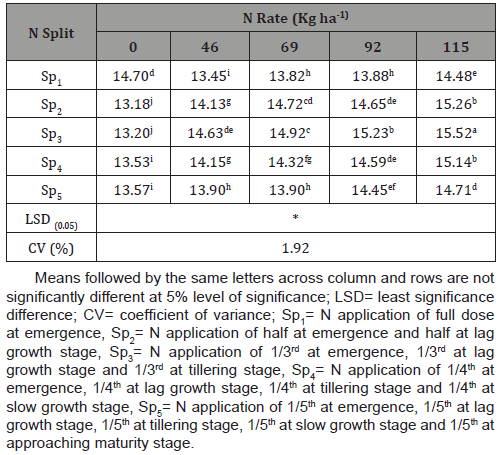
Conclusion
Maximum rhizome yield and better oleoresin content was obtained from the application of 115Kg ha-1 N rate in three equal splits (1/3rd at emergence + 1/3rd at lag growth stage + 1/3rd at tillering) as compared to the commonly used two times split application practiced in many crops. Therefore, application of 115Kg N ha-1 in three equal splits can be suggested for the farmers in the study area to maximize their rhizome yield and quality.
Acknowledgement
We would like to thank Ethiopian Institute of Agricultural Research for funding the project and Tepi National Spice Research Center for technical support and providing experimental area for the research.
Conflict of Interest
No conflict of interest.
References
- Purseglove J, Browen E, Green C, Robins S (1981) Spices. Longman Group Limited, London 1(2).
- Girma H, Digafie T, Edossa E, Baley Y, Weyessa G (2008a) Spice research achievements, revised edition. Ethiopian Institute of Agricultural Research, Addis Ababa, Ethiopia.
- Maseresha Y (2010) Market profile on spices of Ethiopia. Presented to UNCTAP ITC, Addis Ababa, Ethiopia.
- Herms S (2015) Business opportunities report Spices #6 in the series written for the “Ethiopian Netherlands business event 5-6 November 2015, Rijswijk, The Netherlands. Internet document.
- Addisu A (2014) Spice, herbs and aromatic plants subsector platform. In: 1st Ethiopian Spice Platform Stakeholders Meeting. Addis Ababa, Ethiopia.
- Singh P, Srivastava R, Sharma A, Hore D, Panwar B (2001) Genetic variability and correlation in turmeric (Curcuma longa L.). Indian journal of hill farming 14: 24-28.
- Agere L, Shiferaw T (2015) Determination of optimum rate of nitrogen and phosphorous fertilizers for the yield and yield components of turmeric (Curcuma longa L.) on Nitisols at Yaki Woreda Southwestern Ethiopia. Journal of Agricultural Science Research, 3(10): 289-295.
- Ravindran P, Ravindran K, Nirmal B, Sivaraman K (2007) Turmeric: the genus Curcuma; Medicinal and aromatic plants-industrial profiles. Pp. 234-236.
- Saifudeen N (1981) Foliar diagnosis, yield and quality of turmeric (Curcuma longa L.) in relation to N, P and K. MSc Thesis. Kerala Agricultural University, Thrissur, Kerala, India.
- Randall C, Rowe D, Curwen D, Ferro N, Loria R, Secor G (1993) Potato health management. APS Press, USA, 178 p.
- Hyatt C, Venterea R, Rosen C, Mc Nearney M, Wilson M, Dolan M (2010) Polymer coated urea maintains potato yields and reduces nitrous oxides emissions in a Minnesota loamy sand. Journal of Soil Science Society of America 74: 419-428.
- Sithole S (2007) A guide to potato growing. Department of Agriculture. Paris: The international fertilizer industry association
- Follett R, Hatfield J (2001) Nitrogen in the Environment: Sources, Problems, and Management. Optimizing Nitrogen Management in Food and Energy Production and Environmental Protection. In: 2nd International Nitrogen Conference on Science and Policy, pp. 920-926.
- Jagadeeswaran R, Arulmozhiselvan K, Govindaswamy M, Murugappan V (2004) Studies on nitrogen use efficiency in turmeric using 15N tagged urea. Journal of Nuclear Agricultural Biology 33(2): 69-76.
- Girma H, Digafe T, Wondyfraw T (2008b) Yield and quality evaluation of ginger (Zingiber officinale Rosc.) collections and introductions. In: 1st Ethiopian Horticultural Science Society, Addis Ababa, Ethiopia, pp. 215- 220.
- Abayneh E, Ashenafi A (2005) Soils of Tepi and Haru Agricultural Research Sub centers, Soil Survey and Land Evaluation Section. National Soil Research Center, Ethiopian Institute of Agricultural Research, Addis Ababa, Ethiopia.
- Hikaru A, Amzad H, Yukio I, Kenichi Y, Kazuo H, et al. (2007) Effects of application of N, P and K alone or in combination on growth, yield and curcumin content of turmeric (Curcuma longa L.). Plant Production Science 10(1): 151-154.
- ASTA (American Spice Trade Association) (2002) A concise guide to Spices, Herbs, Seeds, and Extractives. American Spice Trade Association. Pp. 48-50.
- Daniel B, Solomon A, Wossen K (2008) Laboratory manual for plant products analysis. Technical Manual 1(23): 3-10.
- Guenther E (1972) The production of essential oils: methods of distillation, effleurage, maceration and extraction with volatile solvents. Florida, USA: Kreieger Publ Co Malabar.
- Rao P, Ganesha Rao E, Puttanna R, Ramesh S (2005) Effect of harvesting time on oil yield and oil quality of Ocimum basilicum. Indian Perfumer 49: 107-109.
- SAS (Statistical Analysis System) (2008) SAS Institute. Cary, North Carolina, USA.
- Marschner H (2002) Mineral nutrition of higher plants. 2nd edn. Academic Press Inc, New York. 447p.
- Patricia I, Bansal S (1999) Potassium and integrated nutrient management in potato. A paper presented at the Global Conference on Potato. New Delhi, India.
- Sangwan N, Farooqi A, Shabih F, Sangwan R (2001) Regulation of essential oil production in plants. Plant Growth Regulators 34: 3-21.
- May A, Barbosa J, Cecilio A, Cavarianni R (2005) Turmeric (Curcuma longa L.) development and productivity in function at nitrogen and potassium doses. Revista Brasileira de Plants and Medicinals 7: 72-78.
-
Behailu Mekonnen, Weyessa Garedew. Nitrogen Fertilizer Rate and Time of Application Affected Yield and Quality of Turmeric (Curcuma longa L) at Tepi, Southwestern Ethiopia. World J Agri & Soil Sci. 2(3): 2019. WJASS.MS.ID.000538.
-
Windbreak, Crop, Grass, Pasture, Agriculture, Yield, Sustainability
-

This work is licensed under a Creative Commons Attribution-NonCommercial 4.0 International License.






